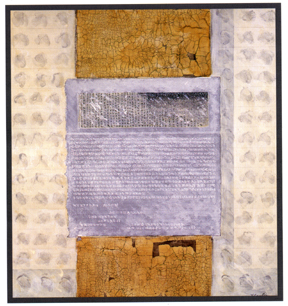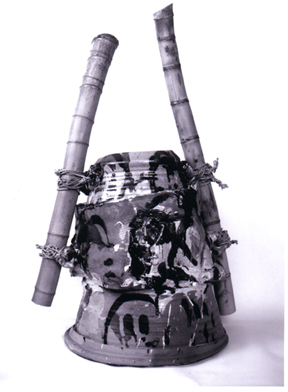Yale Epstein & Jolyon Hofsted at the Watermark/Cargo Gallery
By
RAYMOND J. STEINER
ART
TIMES Nov 2003
 "Inscription VII" - A (gesso, acrylic, ink, handmade paper, varnishes on wood) by Yale Epstein |
MORE OFTEN THAN not, a two— or more — person show can work at a disadvantage to, if not all artists on view, at least to those with work not strong (or good) enough to hold its own. This was certainly not the case here* — seldom do the creative visions of two artistic minds — and a painter and sculptor at that! — function so well together, each intensifying the other, both carrying on a silent dialogue that both simplifies and deepens their individual and combined content at one and the same time. To begin with, neither artist is expressing an easily translatable theme or "message" through either simple representational or figurative imagery and yet both appear to be shedding light on the significance of the work of his fellow exhibitor. On the other hand, neither is dealing in straightforward abstraction — far from it, in fact. Yale Epstein, using primarily a two-dimensional format and combinations of such materials as oil, ink, wax, pastel, pencil, gesso, goldleaf, acrylic, vellum, graphite, paste, silk, aquatint and varnish on wood and/or paper, works in fragmentary fashion, employing both broken color (sometimes harmoniously, sometimes not) and partial assemblage, to convey a sense of unfinished or un-realized language/message from the past. Though he sometimes uses what is obviously some kind of calligraphy, hieroglyph or ideogram — in brief some real (e.g. Hebrew in "Lamentations I" or Oriental in "Inscription I") or imaginary (cf. e.g. "Ancient Tablet") written script — often it is through a juxtaposition of either imposed form (primarily rectilinear, totemic) or color (mostly muted) that leaves the viewer under the impression that something is being "said" here, some communication that, if only deciphered, would yield enlightenment. That this hinted intelligence might be of some import is suggested by a variety of techniques: size, configuration, but most often, title. We are told that we are viewing "Sacred Walls," "Inscriptions," "Tablets," "Talismans," or "Legends" — at other times we are informed that we are participating in a "Discovery," a "Journey," or a "Lamentation." Never, however, is the "message" clear (at least to this viewer); nevertheless, one ds come away with some intellectual or emotional impact — no matter how vague or undecipherable the visual context or intent is (the title, of course, helps one to "get" sorrow (cf. "Lamentations") or solemnity ("Sacred Wall"). Such is the overall dynamics of Epstein’s art that, whatever rational "spin" one chooses to put on the experience of viewing his work either individually or collectively — there are some thirty-four pieces — one is convinced that one has undergone some subtle transformation, some initiation into ancient mysteries that somehow eludes our vocabulary to elucidate. We know something "happened" — that some inner (and more primitive) self has been somehow "touched" — but not precisely how it happened or what it was.
Interspersed with and playing against Epstein’s work — both mounted on the walls and strategically placed here and there on the floor of the several "galleries"— are Hofsted’s three-dimensional sculptures — all comprised of two materials: ceramic and bamboo (though in some cases, the bamboo is attached to their ceramic elements with heavy twine and a gelatinous fixatif that appears to be either melted wax or glue that binds the disparate components). Again, as with Epstein’s reappearing elements, Hofsted’s repetitive and consistent use of ceramic and bamboo is a powerful visual mantra that irresistibly engages the mind on some pre-conscious and elemental level. This recurrence of materials is echoed by the vessel-like appearance that characterizes each of the works — all seem to be molded in a consistent container-like form — many seemingly designed for the holding of water, or grain, or — perhaps — even human remains. The clay-work — which sometimes appears to be rough, fragmentary, and ill-handled (purposely so, one eventually comes to realize) when considered in isolation — yet produces in the end a highly sophisticated and final configured whole that is both pleasing to the eye and functionally apt. Thick slabs of clay that seem to be haphazardly stuck on here and there, meld into a harmonious aggregate when viewed at the proper distance (much like what occurs when stepping back from the blobs and splashes of an impressionist painting). Because of their spatial presence, their three-dimensionality, Hofsted’s pieces are as forcibly iconic in their impact — as spiritually expressive — as are Epstein’s suggestive glyphs, in spite of (or perhaps because of) the fact that, once again, we are not made aware of their particular purpose or use. Both men vary the size of their conceptual products — Epstein, from 11 1/4"x9 1/2" to 44" x 21" and Hofsted, from 5"x14"x9" to 16"x16"x50" high — i.e., from intimate to large-scale dimensions. Also as with Epstein’s vision, Hofsted’s work throws us back into a past that is redolent of prehistoric ceremony, funereal rites, and the mysteries of combing fire and earth. Some of the thick, rough-hewn clay segments that form the bodies of Hofsted’s vessels seem of volcanic origin, formed by nature rather than by human hand (or intelligence).
 "Rebel's Voice" (Ceramic and Bamboo) by Jolyon Hofsted |
I felt compelled to view this exhibit in silence, treading noiselessly around the separate works, as if not to disturb their aura, their eerie and numinous presence — much as if I were circumambulating the nave of some image-filled cathedral. Showing these two artists in tandem was a stroke of pure inspiration — and I have rarely come across such a happy marriage of placement and artwork such as this. We have grown used to works of art being taken out of context — ripped from their original sites (and intents) only to be housed in museums of different locations — not to mention different cultural contexts. Today, of course, most art is created for museum venues (or hopefully so) and not, like in former days when it was created, if not in situ, at the very least for a specific time and place. Ben Wigfall, director of the Watermark/Cargo Gallery, has managed to bring some of the seriousness of art back in this present exhibition — turning his gallery — at least for the moment — into a holy place, a place where the magic of the unknown intersects our mundane world. As with myth-making, good art-making ought to always be somewhat enigmatic, not created to give mankind answers (which are invariably incorrect or incomplete), but rather to present a framework in which we may re-think our relationship to the greater mysteries of life with a new and altered vision. But then Wigfall, a knowledgeable collector and dealer in the art of Africa, knows the power and seduction of the intuitive — and deserves kudos for bringing it so dramatically to our attention through these two most engaging artists.
*"Yale Epstein: Mixed Media Works & Jolyon Hofsted: Ceramics: New Work" (Sep 13—Oct 26): Watermark/Cargo Gallery, 111 Abeel St., Kingston, NY (845) 338-8623
